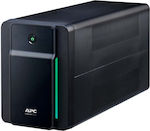In one word... I wasn't impressed.
What I liked:
It is small.
It has a cute screen.
The battery life was confirmed to be 7 hours at half load, i.e. 250W.
It works for the job I need it for. 2 shutters, each 125W (yes, they work simultaneously).
What I didn't like:
Pure Sinewave? Not at all. When there is no power outage, it naturally provides power from the grid, so there it is pure sinewave (like the simplest ups on the market). Also, when it operates on battery and there is no device connected (no load image), the output has a slight distortion. However, in tests with 100W bulbs, 250W bulbs, and a 250W motor, you can see the results of the oscillograph in the photos. There are so many harmonics that if you connect a speaker, you will hear a melody!
Efficient charging? I don't know. The only thing I understood is that after 8 hours plugged in with a sufficiently charged battery and an ambient temperature of 20 degrees, it heated up significantly. Note that there was no device operating on it.
Why does it matter to me? Simply because in these ups, the battery deteriorates within 2 years due to temperature. And don't tell me that you've had it for 5 years and it still works, because you will notice it in the first power outage that lasts only 1 minute. As soon as the warranty expires, I will drill holes in it for ventilation (Do not try this at home, I am not responsible).
The screen does not measure power in watts, but in bars. The battery indicator is approximately accurate. The light does not turn off and is intense.
800VA - 480W Enough with this deception. It is 480W at best (that's why the battery life is given for 240W).
We say that it is suitable for Active PFC power supplies where power factor = 1, meaning VA = W, and we give VA values for power factor = 0.6. For those who do not know the theory, W = VA * power factor. You will tell me that everyone does it. Why should Powerwalker be exempted?
Where I wouldn't use it:
Not for loads with high demands.
Not for refrigerators, not for non-inverter air conditioners, not for motors above 250W, and generally not for motors that have a heavy workload or critical operation (e.g. water pumps, radiator fans in large installations, etc.).
As for expensive PCs with active PFC PSU? You get what you pay for. I don't know how reliable it is in protecting them.












































